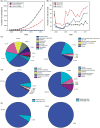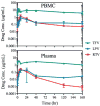Translation of combination nanodrugs into nanomedicines: lessons learned and future outlook
- PMID: 29285948
- PMCID: PMC6205718
- DOI: 10.1080/1061186X.2017.1419363
Translation of combination nanodrugs into nanomedicines: lessons learned and future outlook
Abstract
The concept of nanomedicine is not new. For instance, some nanocrystals and colloidal drug molecules are marketed that improve pharmacokinetic characteristics of single-agent therapeutics. For the past two decades, the number of research publications on single-agent nanoformulations has grown exponentially. However, formulations advancing to pre-clinical and clinical evaluations that lead to therapeutic products has been limited. Chronic diseases such as cancer and HIV/AIDS require drug combinations, not single agents, for durable therapeutic responses. Therefore, development and clinical translation of drug combination nanoformulations could play a significant role in improving human health. Successful translation of promising concepts into pre-clinical and clinical studies requires early considerations of the physical compatibility, pharmacological synergy, as well as pharmaceutical characteristics (e.g. stability, scalability and pharmacokinetics). With this approach and robust manufacturing processes in place, some drug-combination nanoparticles have progressed to non-human primate and human studies. In this article, we discuss the rationale and role of drug-combination nanoparticles, the pre-clinical and clinical research progress made to date and the key challenges for successful clinical translation. Finally, we offer insight to accelerate clinical translation through leveraging robust nanoplatform technologies to enable implementation of personalised and precision medicine.
Keywords: AIDS; HIV; Nanoparticle; cancer; combination therapy; drug targeting; drug-combination nanoparticle; long-acting; targeted drug delivery.
Conflict of interest statement
No potential conflict of interest was reported by the authors.
Figures


Similar articles
-
Smart cancer nanomedicine.Nat Nanotechnol. 2019 Nov;14(11):1007-1017. doi: 10.1038/s41565-019-0567-y. Epub 2019 Nov 6. Nat Nanotechnol. 2019. PMID: 31695150 Free PMC article.
-
Critical quality attributes in the development of therapeutic nanomedicines toward clinical translation.Drug Deliv Transl Res. 2020 Jun;10(3):766-790. doi: 10.1007/s13346-020-00744-1. Drug Deliv Transl Res. 2020. PMID: 32170656 Review.
-
Theranostic applications of peptide-based nanoformulations for growth factor defective cancers.Int J Biol Macromol. 2024 Mar;260(Pt 2):129151. doi: 10.1016/j.ijbiomac.2023.129151. Epub 2024 Jan 4. Int J Biol Macromol. 2024. PMID: 38181914
-
[Development of antituberculous drugs: current status and future prospects].Kekkaku. 2006 Dec;81(12):753-74. Kekkaku. 2006. PMID: 17240921 Review. Japanese.
-
Translating 3D printed pharmaceuticals: From hype to real-world clinical applications.Adv Drug Deliv Rev. 2021 Jul;174:553-575. doi: 10.1016/j.addr.2021.05.003. Epub 2021 May 20. Adv Drug Deliv Rev. 2021. PMID: 33965461 Review.
Cited by
-
Review of Personalized Medicine and Pharmacogenomics of Anti-Cancer Compounds and Natural Products.Genes (Basel). 2024 Apr 8;15(4):468. doi: 10.3390/genes15040468. Genes (Basel). 2024. PMID: 38674402 Free PMC article. Review.
-
Fluorescent Magnetic Nanoparticles for Bioimaging through Biomimetic Surface Modification.Int J Mol Sci. 2022 Dec 21;24(1):134. doi: 10.3390/ijms24010134. Int J Mol Sci. 2022. PMID: 36613578 Free PMC article.
-
Towards principled design of cancer nanomedicine to accelerate clinical translation.Mater Today Bio. 2022 Feb 1;13:100208. doi: 10.1016/j.mtbio.2022.100208. eCollection 2022 Jan. Mater Today Bio. 2022. PMID: 35198957 Free PMC article. Review.
-
Chemical and Biomolecular Strategies for STING Pathway Activation in Cancer Immunotherapy.Chem Rev. 2022 Mar 23;122(6):5977-6039. doi: 10.1021/acs.chemrev.1c00750. Epub 2022 Feb 2. Chem Rev. 2022. PMID: 35107989 Free PMC article. Review.
-
Challenges and opportunities in metastatic breast cancer treatments: Nano-drug combinations delivered preferentially to metastatic cells may enhance therapeutic response.Pharmacol Ther. 2022 Aug;236:108108. doi: 10.1016/j.pharmthera.2022.108108. Epub 2022 Jan 6. Pharmacol Ther. 2022. PMID: 34999182 Free PMC article. Review.
References
-
- Banker GS. Drug products: their role in the treatment of disease, their quality, and their status and future as drug-delivery systems. In: Banker GS, Rhodes CT, editors. Modern pharmaceutics. 4. New York (NY): Marcel Dekker Inc.; 2002. pp. 1–21. revised and expanded.
-
- Kawakami K. Modification of physicochemical characteristics of active pharmaceutical ingredients and application of supersaturatable dosage forms for improving bioavailability of poorly absorbed drugs. Adv Drug Deliv Rev. 2012;64:480–495. - PubMed
-
- Lipinski CA, Lombardo F, Dominy BW, et al. Experimental and computational approaches to estimate solubility and permeability in drug discovery and development settings. Adv Drug Deliv Rev. 2001;46:3–26. - PubMed
-
- Aungst BJ. Intestinal permeation enhancers. J Pharm Sci. 2000;89:429–442. - PubMed
Publication types
MeSH terms
Substances
Grants and funding
LinkOut - more resources
Full Text Sources
Other Literature Sources
Miscellaneous
